The Institute of the Information Society of the Ludovika University of Public Service regularly carries out representative domestic research in the field of the information society. The questionnaires contain both questions suitable for longitudinal research and new topics each year.
This research report examines changes in the information society by assessing the results of a total of four telephone-based surveys conducted between October 2019 and February 2024. All surveys are representative of the Hungarian population by age, gender, education and type of settlement.
Our primary aim is to highlight the general internet and digital device use, news and information consumption patterns of Hungarian society, how they have changed over the past half decade, and some of the more interesting trends. The specificity of the period in question is that the coronavirus epidemic occurred in the middle of this period (2020-2022), so the report also aims to shed light on the areas where the epidemic had a lasting impact on society and the attitudes that have returned to the pre-pandemic period.
1. The smartphone is on the rise, online administration is spreading
The emergence of smartphones has opened up a new era in the flow of information online. The fact that the proportion of people in Hungarian society who own a smartphone has continued to rise significantly in recent years can therefore be regarded as a fundamental data point. While in 2019, 75% of the adult population had a smartphone, by the beginning of 2024, this figure had risen to 89.2%. There was a similar increase in internet usage, from 78.4% to 88.2% of internet users.
It is also clear that a growing proportion of internet users are embracing the potential of digital technology, and that the use of online solutions is becoming a dominant activity in many areas of their lives. The use of the internet for banking (60% vs. 71%), for office administration (55% vs. 70%), for paying utility bills (45% vs. 55%) and for online shopping (65% vs. 74%) all show significant increases of around 10%.
In addition to everyday needs, there is an even more significant shift in some areas of entertainment. While 21% in 2019, 54% of respondents in 2024 will say they watch films through subscription (typically streaming services) rather than exclusively on free sites or via free downloads.
The problem-solving value of the Internet (2019-2024)
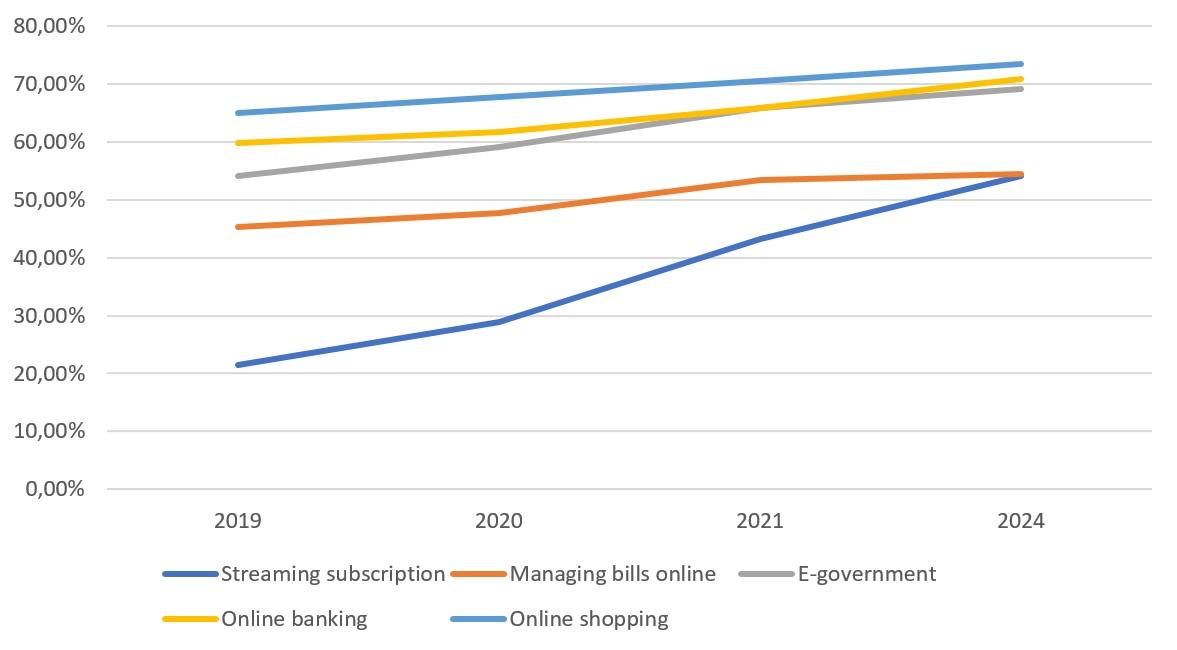
A key usage characteristic for staying safe online is that, despite efforts and awareness campaigns to encourage the use of filtering software, more than a third of the population do not pay attention. In 2019, 28% used such a tool and this figure has not shown a significant increase over the last four years (32.4% vs. 33.9%).
2. We are increasingly informed by social media, even though we do not trust it
Although the presence of "traditional media" (radio and television as well as print newspapers) as information channels is still significant, there is a clear trend towards the advance of online information. The proportion of people who do not use television to find out about world news has increased from 13.9% in 2019 to nearly 30%. In the case of radio, the proportion of those "ignoring" this type of media increased from 29.3% to 38%. The younger the generation, the greater the disengagement: for television, it reaches 44% among young adults (up from 26.5% in 2019), but it has also increased to 12% among the oldest generation (up from 6.6% in 2019). The question on the use of print media as a source of information showed an even more drastic decline, with the proportion of non-readers of print media increasing from 56% to 78.6% for national newspapers and from 51% to 71% for local newspapers. In the case of print media, no generational differences are apparent in terms of disengagement, with each age group following a parallel trend with a few percentage points difference.
The opposite trend was observed for the proportion of people using social media for information purposes. Among the total population, the proportion of people who do not use Facebook and other social networking sites at all has fallen from 36% to 28% in five years (from 25% to 15% of internet users).
Channels of information seeking
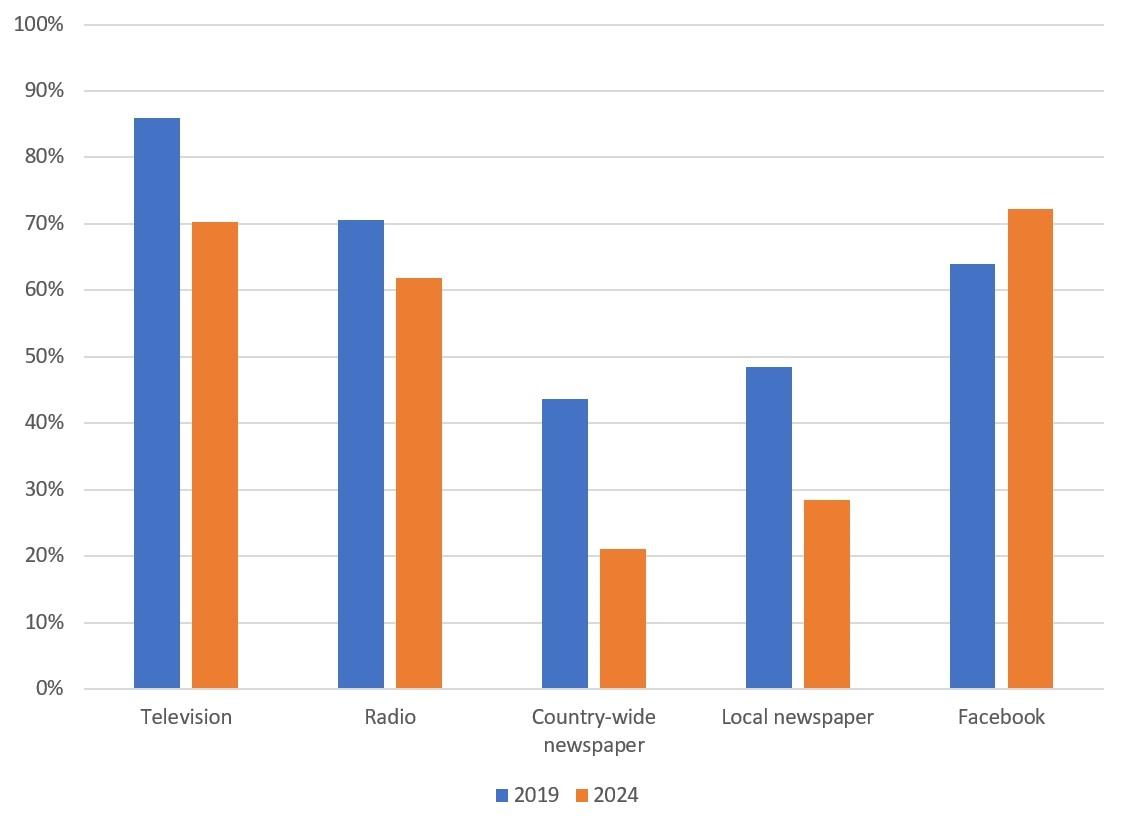
While the data presented above show that the digital space, and social networking sites in particular, is gaining ground in terms of both usage and information seeking habits, the question of trust in these tools shows a contrary trend. In the first survey, 31% of people did not trust the credibility of information from social media, but by 2024 this figure had risen to 40%. However, there are significant differences by level of education: the distrust of those with a school-leaving certificate has risen virtually steadily, the trust of those with up to eight general secondary education and those with vocational training has fluctuated significantly, but has barely deteriorated overall, while among graduates recent years have seen a significant disappointment.
Proportion of people who do not trust social media as a source of information

3. Hungarian news consumers have become more active
It can be observed that while the proportion of respondents showing interest in public news did not change significantly over the period covered by the research, there was a significant change in the way this type of news was consumed. Indeed, while in the 2019 survey 55% of people read only the news that came in front of them and only 34% looked for this type of information, by 2024 the proportion was 43% vs. 41%. The 2024 data therefore no longer support our earlier finding that the majority of Hungarian society can be considered passive consumers of news. It is worth noting that data on news consumption activity started to increase during the pandemic.
Consumption of public affairs news
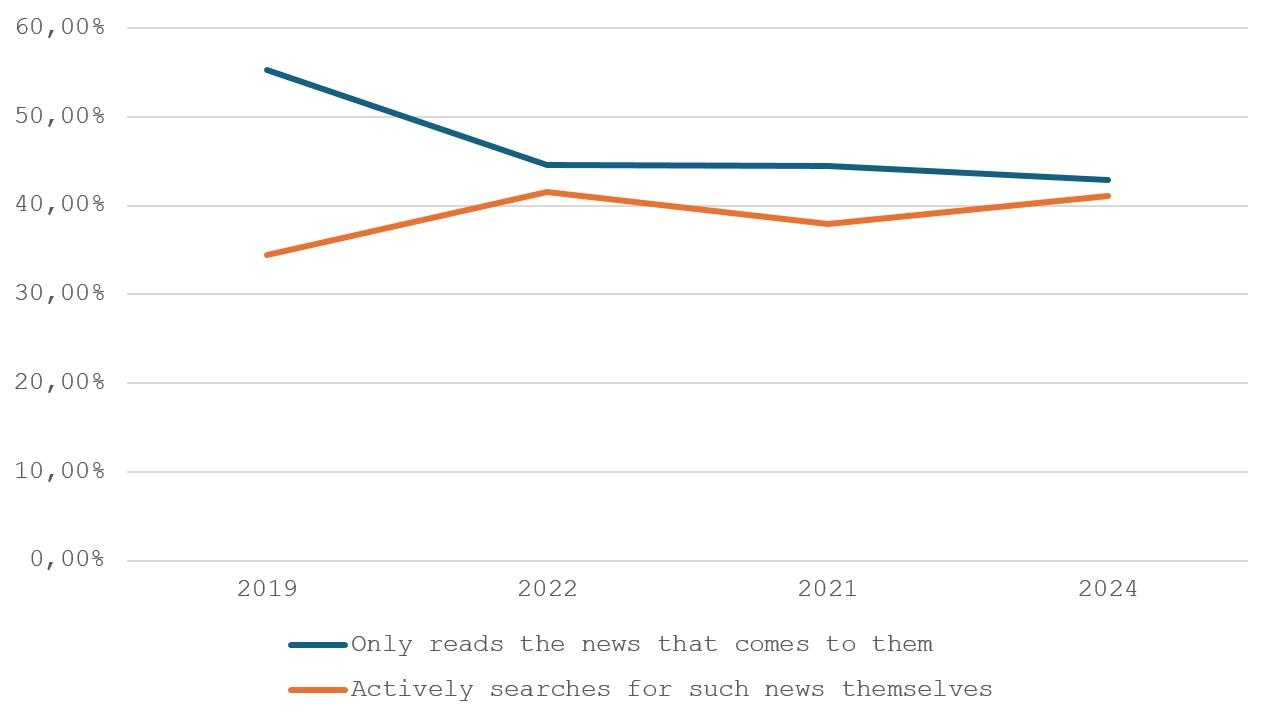
The change is particularly striking for the oldest age group: in the first survey, passive news consumers were still in the majority in this social group (53% vs. 41%). In this year's survey, the trend has reversed, with one in two people aged 60+ saying they are active news consumers and 42% reading only the news that comes in front of them (the remaining 8% either do not care or did not respond).
As regards interest in public positions that differ from one's own convictions, the research also shows an increase in activity and the need for broad information. While 73% showed interest in such content in 2019 (vs. 24%), the 2024 results show 79% vs. 16%.
To summarise the change in attitudes towards news consumption, it can be observed that, on the one hand, respondents are more active in obtaining information in the post-epidemic period and, on the other hand, they are more open to hearing opinions different from their own on a given issue.
4. We have a more realistic view of the internet
Optimism about the benefits and risks of the internet has declined over the past half decade. In 2019, 55% considered the internet to be beneficial in terms of the ability to get information quickly and directly, and 36% considered it risky because of the uncontrolled flow of information. These figures changed to 50% vs. 40% in 2024, meaning that the number of people with positive attitudes decreased by about 5% and the number of people with negative attitudes increased by the same percentage.
Is the Internet advantageous or risky?
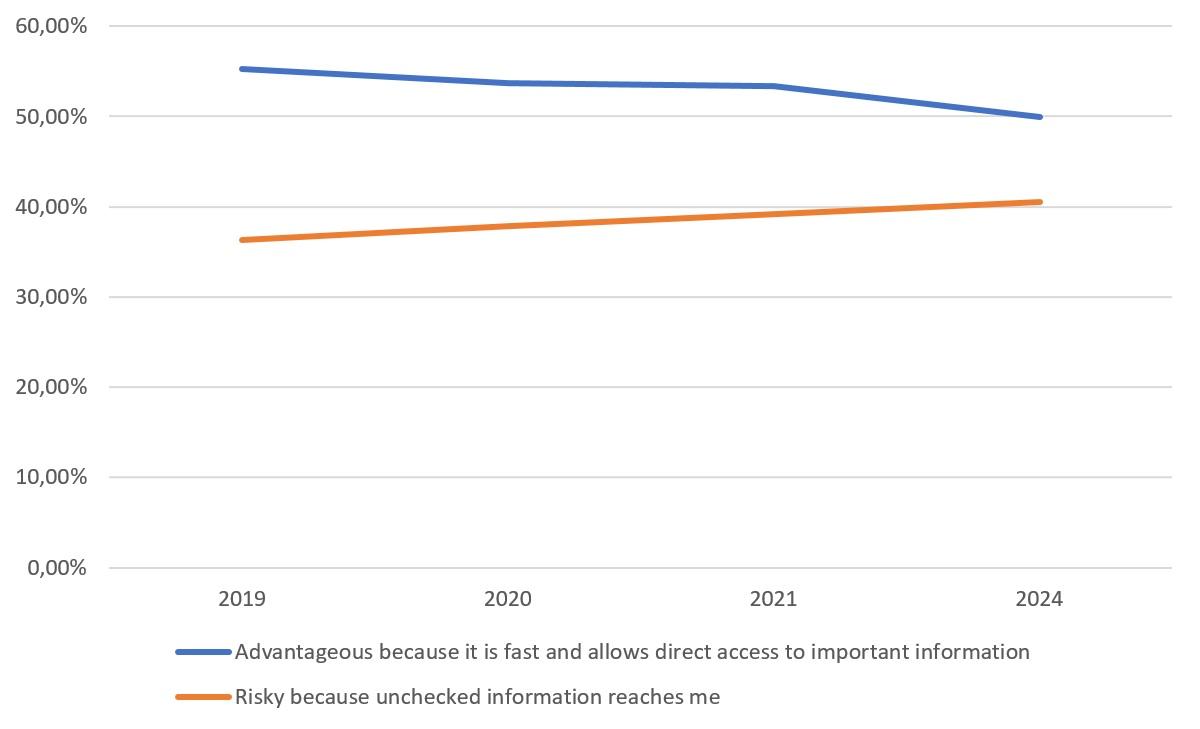
5. The perception of online social discourse
There was also a negative shift in social attitudes towards the use of the internet to communicate and share opinions. In 2019, there were roughly 10% more people who think the internet is beneficial because ordinary people can share their views with the public than those who think the internet is risky because it allows views that are dangerous to society to be freely shared (50% vs. 40%).By 2024, this gap had narrowed to less than 3% (47% vs. 44%).
A similar pattern can be observed for anonymous comments. In the first survey, just over one in four respondents had a positive attitude (26%) to this online option and two thirds (67%) considered it harmful because it encourages irresponsible comments; these proportions shifted slightly to 23% vs. 70% in 2024.
Overall, however, the proportion of people who think Facebook is excellent as a social forum, for being active on public issues, expressing opinions and debating has not changed: 46.2% in 2019 and 46.9% in 2024 think this is either entirely or at least mostly true.
To what extent can Facebook be used as a social forum?
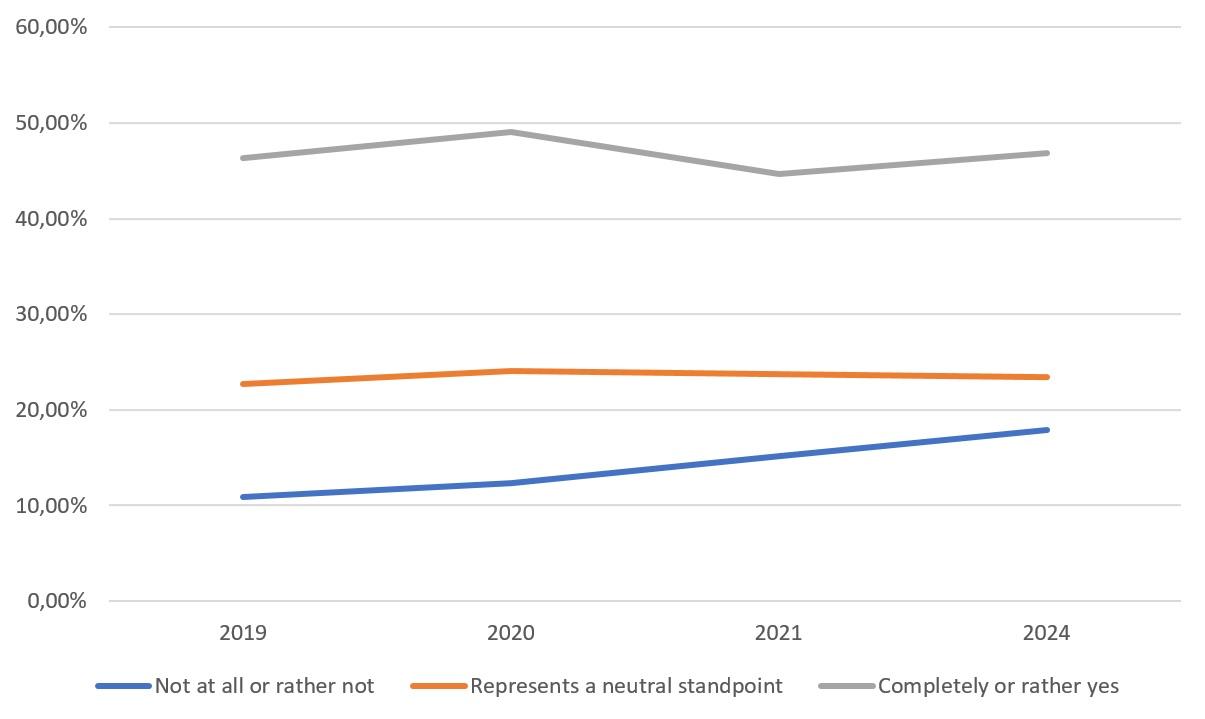
The research was led by Árpád Rab and Bernát Török.
The summary was prepared by Árpád Rab, Tamás Szikora and Bernát Török.